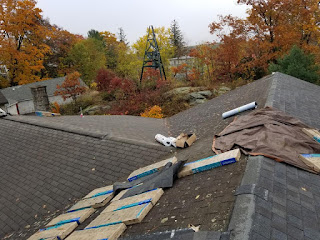Everything You Need to Know about Roof Flashing and Why It Matters
What is Roof Flashing?
Flashing is made of thin, sturdy materials—most commonly metals like aluminum, copper, or galvanized steel. It’s installed at critical roof points, such as intersections, edges, and areas around chimneys, skylights, and vents. The primary purpose is simple yet vital: redirect water away from seams and joints to prevent leaks.
Without proper flashing, water can seep into the roof structure, leading to issues like rot, mold, and insulation damage.
Different Types of Flashing and Their Functions
Each type of flashing addresses a specific roofing challenge, keeping every corner of a roof secure:
● Step Flashing: Placed at roof-wall intersections, step flashing directs water away from the joint instead of allowing it to seep in.
● Valley Flashing: Positioned in roof valleys, it channels rainwater directly into gutters, preventing water pooling.
● Drip Edge Flashing: Installed at roof edges, this flashing keeps water from running down fascia boards, preserving the structural integrity of the roofline.
● Counter Flashing: Adds an extra protective layer over step flashing, sealing areas around chimneys and walls.
Proper selection and placement are essential for a roofing system to function efficiently.
The Critical Role of Installation
Even the highest-quality materials become ineffective if flashing is not installed correctly. Misaligned flashing, insufficient overlapping, or improper sealing can create gaps that allow water to penetrate the roof. For example, poorly aligned step flashing may channel water behind shingles, leading to significant damage over time.
This is why professional installation is crucial. Experienced roofers ensure flashing is placed securely, with attention to the smallest details that can make a difference in long-term performance.
Addressing Weather Challenges
Maine’s harsh winters and heavy rainfall make roof flashing an essential component of any roofing system. In winter, ice dams—ridges of ice that trap melting snow—can force water to back up under shingles. Properly installed flashing prevents this water from reaching vulnerable areas, directing it safely away from the roof structure.
In warmer months, flashing must withstand temperature fluctuations, expanding and contracting without compromising its seal. High-quality materials ensure flashing remains resilient against these stresses.
The Importance of Maintenance
Like every component of a roof, flashing requires regular inspection and maintenance. Over time, exposure to the elements can lead to rust, cracks, or loosening. Identifying these issues early is crucial to avoid costly repairs.
Periodic maintenance involves checking flashing for signs of wear and tear, clearing debris that may obstruct water flow, and confirming seals remain intact. Regular, proactive care can significantly extend the lifespan of both the flashing and the roof as a whole.
Why Flashing Matters for Your Roof
Flashing is a crucial investment in your roof’s longevity and durability. With proper installation, regular maintenance, and high-quality materials, flashing effectively prevents leaks and preserves the structural integrity of your home. Whether shielding against heavy rainfall or enduring the freeze-thaw cycles of winter, flashing serves as a silent guardian, working tirelessly to ensure your h
ome’s security.
Protect your home with expertly installed and maintained flashing. At Freeman & Son Construction, we’re here to help you build a durable, weather-resistant roof. Call us today to schedule an inspection or discuss your roofing needs.



Comments
Post a Comment